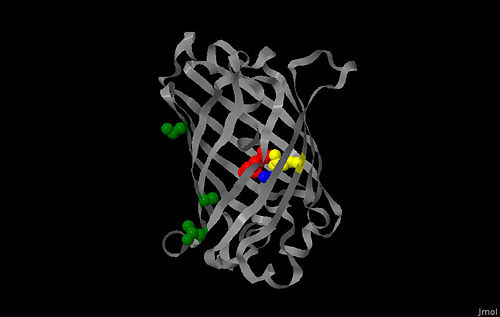User:Lois A. Fridmann/Sandbox 1
From Proteopedia
Contents |
c3-GFP Mutant - PDB 1b9c
Green Flourscent Protein Mutant F99S//M153T/V163A
with the fluorescent chromophore at the center of the barrel structure
accompanied by two water molecule and glutamate 222. The three
mutant amino residues are found on the surface of the protein.
Background
Considerable variations of the Green Fluorescent Protein (GFP) have been created in order to help determine the structure and function of the wtGFP. These mutations have been made in order to enhance the use of GFP as a reporter of gene regulation and expression, protein transport and heredity. GFP has been mutated to provide an increased or alternative color for fluorescent, fluorescence for a greater time period and to make it less susceptible to photo bleaching. The specific GFP mutation featured in this page is referred to as F99S/M153T/V163A or cycle 3 GFP (c3-GFP).
|
The overall characteristic of the c3-GFP closely resemble the wtGFP, however due to the three mutations it is 42-fold more fluorescent in vivo compared to wtGFP. This phenomenon arises because the replacement of the hydrophobic amino acids with hydrophilic or less hydrophobic amino acids causes less aggregation and results in improved autocatalytic activation of the chromophore. The reduction in the hydrophobic nature on the surface of the c3-GFP also results in an increased ability of the mutant to mature in vivo effectively at 37 degrees Celsius. This is a feature the wtGFP lacks because the A. victoria jellyfish in the Pacific Northwest, from which it was first extracted, had never experienced such high temperatures. Thus the wtGFP has its limitations as a gene expression marker. The c3-GFP mutant is unique because unlike most mutants, the structure of the chromophore and the fluorescence spectrum remains the same as the wtGFP. The enhanced c3-GFP provides for a better tool for researchers as compared with the wtGFP.
Structure
This structure exhibits at the 99 residue site where Phenylalanine is replaced with Serine, the 153 residue site where Methionine is replaced by Threonine, and the 163 residue site where Valine is replaced with Alanine. The mutant residues of c3-GFP are located near the surface of the protein and on separate beta sheets. They are not in close proximity to the and subsequently do not directly interfere with the normal cyclization and formation of the chromophore. is present in this model because it is one of the most conserved residues in GFP. Two water molecules are also featured in this model because of their involvement in A and B chains of the c3-GFP, while the C and D chains, which are not represented, contain three water molecules.
Notes and Literature References
- Battistutta R, Negro A, Zanotti G. 2000. Crystal Structure and Refolding Properties of the Mutant F99S/M153T/V163A of the Green Fluorescent Protein. Proteins: Structure, Function, and Genetics 41:429 – 437.
- Crameri A, Whitehorn E, Tate E, Stemmer W. 1996. Improved Green Fluorescent Protein by Molecular Evolution Using DNA Shuffling. Nature Biotechnology 14:315 - 319.
- Fukuda H, Arai M, Kuwajima K. 2000. Folding of Green Fluorescent Protein and the Cycle3 Mutant. Biochemistry 39:12025 – 12032.

